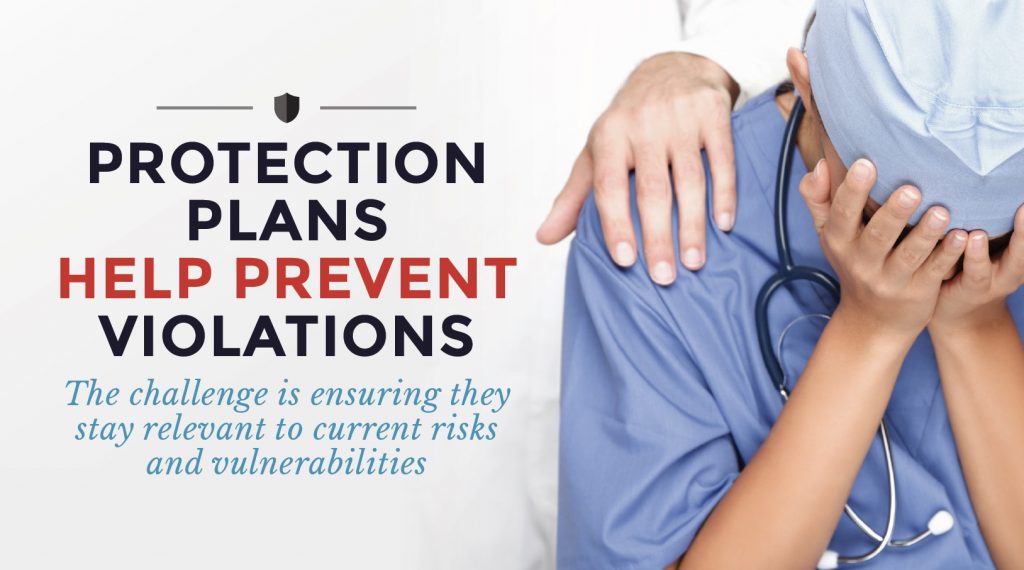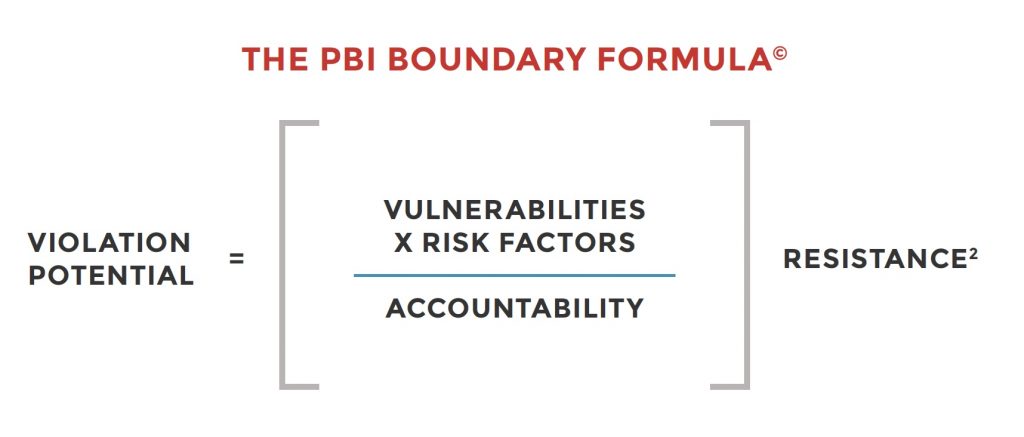Protection Plans Help Prevent Violations
Protection Plans Help Prevent Violations
The challenge is ensuring they stay relevant to current risks and vulnerabilities

As noted earlier, people generally begin PBI classes in a state of denial. They blame others for their violation—often the board, sometimes the victim, never themselves. Yet by the end of the third day, most have come to accept their guilt and at least begun to understand both the harm they have caused and how they came to commit a violation they now so deeply regret.
Making their way from denial to acceptance is an intense, often painful experience. To make the most of it, PBI students use what they have learned to create an action plan that will help them avoid committing another violation in the future.
Protection Plans address personal and professional issues, as well as organizational challenges. Protection plans are divided into three parts, which is why we call them Stratified Boundary Protection Plans. Because violations of professional boundaries are often the result of personal problems, it’s important for violators to tackle vulnerabilities and risks in both their work and their personal lives. Doing so encourages them to consider the relationship between these two realms and to look at the challenges that so often arise at the interface between them.
A physician having marital problems who has been disciplined for seeing patients outside of normal office hours, for example, might commit to couples counseling in the personal section of her plan and to strict adherence to office hours in the professional section. The same person might pledge to spend more time at home with her family and to reduce the number of hours she works during the week.
The organizational part of the protection plan forces people to confront the work environment they often take for granted. The physician who commits to limiting her hours at work jeopardizes the effectiveness of her protection plan if she fails to acknowledge that her colleagues all work 80 hours a week and are unlikely to take kindly to her reducing her time in the office. In the organizational part of her plan, she can outline steps to deal with this complication, perhaps sharing the reasoning behind her resolve with her partners or, if the problem is severe enough, moving to another practice.
The Boundary Formula© is essential to creating and revising plans. PBI stresses in all its courses that protection plans are never really final, because the “final draft” created in class simply reflects people’s situation at that moment. And situations change. The steps a person outlines in their Protection Plan may serve them well for a while, but at some point, their plans will be rendered obsolete, or at least outdated, by changes they could not have anticipated during the class.
The PBI Boundary Formula,© is what makes it possible to create a plan in the first place, and to revise it as needed throughout a career. Despite its format, the formula is not a mathematical equation but an easy-to-use description of the forces at work in any boundary violation and how those forces relate to each other.

In broad strokes, the formula says that your potential to commit a violation is determined by your individual vulnerabilities, which are magnified by the risks you face at work. Mitigating against these tendencies towards violation is the degree to which you feel accountable. The more accountable you feel, the less likely you are to commit a violation.
The final factor in the formula, Resistance, is given exponential power, because when you refuse to look at your own vulnerabilities and the risks you face, you surrender any chance you have of dealing with these forces. Worse still, if you refuse to even consider that you may be missing something—if you resist looking at your own resistance—the threat you face is raised to a higher power still—Resistance2.
We’ll delve further into each of the elements in the formula in future issues. What’s important to understand here is that the formula provides a framework for evaluating and re-evaluating a person’s violation potential as their life situation changes.
Both positive and negative changes in life—the death of a spouse or a promotion at work, say—can awaken personal insecurities that make a person vulnerable in ways they never anticipated. What the formula says is that you can reduce your violation potential by acknowledging these new vulnerabilities, despite your urge to ignore them, and by taking steps to reduce the risks you now face—either by avoiding specific situations altogether or by increasing your accountability.
A male physician who suspects his wife of being unfaithful, for instance, can use the formula to consider how his new situation increases his risk of responding inappropriately to a female patient. Aware of his heightened violation potential, he can reduce his risk by limiting his practice to men or by including a chaperone whenever he sees a patient of the opposite sex.
It’s important to invite constructive criticism. The danger of course is that each of us, as human beings, is often blind to our own problems. The physician who’s anxious about his marriage, for instance, may well miss how his personal problem increases his violation potential. That’s why we have the people in our courses present drafts of their protection plans to the whole class. Having worked together for three intense days, class members know each other well enough to offer constructive criticism and trust each other enough to accept the criticism that’s offered—at least most of the time. If the doctor in question failed to address his marital problems in his protection plan, his classmates would almost certainly challenge the omission.
Once someone is back in practice, it can be difficult to elicit such honest feedback. Professionals with a history of violation are often understandably reluctant to share professional concerns with colleagues or even with trusted friends. That’s why we offer ongoing Maintenance and Accountability Seminars (MAS). These weekly conference calls allow PBI graduates to discuss challenges with others who know what they are going through. And the safe environment of the confidential call empowers people to seek feedback and to offer sometimes challenging perspectives.
The feedback from the group is not always easy to accept. People have been persuaded, often with great reluctance, to pass up promising business ventures, back out of budding relationships, and change long-standing habits. Others have been pushed to recognize important lapses and supported in taking the difficult steps required by their protection plans. And the process of sharing also serves another important function: as those on the call listen to the challenges others are facing, they are often alerted to issues in their own lives that might otherwise have gone un-noticed.
Not everyone chooses to participate in MAS, but those who do often find it so helpful that they continue joining the weekly calls for years.
View Other Posts
- Summer School: Reduce Stressors, Avoid Burnout
- Don’t Wait Until it is Too Late: How a Personalized Protection Plan© Decreases Violation Potential
- The What, Why, When, and How of Remedial Educational Interventions
- Revisiting Moral Courage as an Educational Objective
- If It Isn’t Documented, It Didn’t Happen
